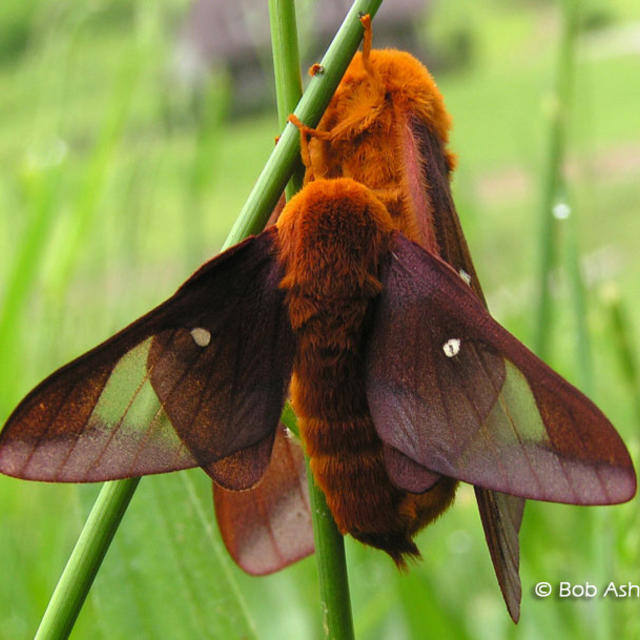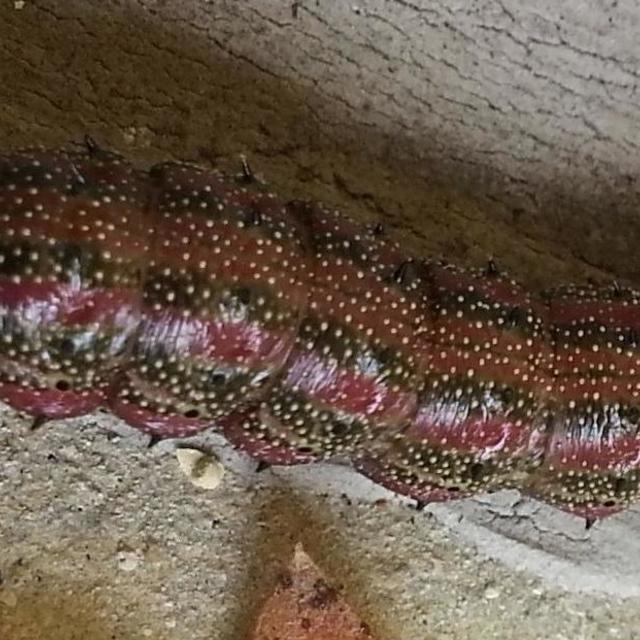Pink-striped oakworm moth
Anisota virginiensis (Drury, 1773)
Family: Saturniidae
Subfamily: Ceratocampinae
Identification: Females are larger than males. Upperside of female is orange with pale purple at the margins of the wings. Scattered black specks are reduced or absent. Upperside of male is dark brown with some red on the hindwing and a large translucent white spot on the forewing. Both sexes have a small white cell spot on the forewing.
Wing Span: 1 5/8 - 2 5/8 inches (4.2 - 6.6 cm).
Life History: Adults are day fliers and mate in the morning. Females lay eggs after dusk in groups on the underside of oak leaves. Caterpillars feed together in groups, and pupate and overwinter in shallow underground burrows.
Flight: One brood from June-July in the north, at least two broods from May-September in the south, several broods throughout the year in Florida.
Caterpillar Hosts: Various oaks (Quercus species).
Adult Food: Adults do not feed.
Habitat: Deciduous woodland, suburbs, tree-lined city streets.
Range: Nova Scotia west across the Great Lakes states to Manitoba and Minnesota; south to central Florida, the Gulf Coast, and east Texas.
Conservation: Not usually required.
NCGR: G5 - Demonstrably secure globally, though it may be quite rare in parts of its range, especially at the periphery.
Management Needs: None reported.
Comments: NULL
Get your BAMONA Gear!
Please donate!
We depend on donations to keep Butterflies and Moths of North America freely available. We want to express our gratitude to all who showed their support by making a contribution this year. You can donate to support this project at any time.
Advertise with us!
Do you have a product or service that you think would interest BAMONA users? If you would like to advertise on this website, contact us by email, or use the contact form and select the "Advertising" category.
Verified Sightings
Displaying 1 - 24 of 836 verified sightings

Observation date: Sep 01, 2024
Submitted by: Ekawa94
Region: Darlington County, South Carolina, United States
Verified by: Dennis Forsythe
Verified date: Sep 02, 2024

Observation date: Aug 12, 2024
Submitted by: Dan Hickey
Region: Botetourt County, Virginia, United States
Verified by: rogerdowner
Verified date: Aug 30, 2024

Observation date: Aug 26, 2024
Submitted by: lynxclaws
Region: Habersham County, Georgia, United States
Verified by: Mikelchap
Verified date: Aug 28, 2024

Observation date: Jul 06, 2024
Submitted by: ALolasaurusRex
Region: Wilson County, North Carolina, United States
Verified by: rogerdowner
Verified date: Aug 16, 2024

Observation date: Aug 07, 2024
Submitted by: ktew
Region: Brunswick County, North Carolina, United States
Verified by: rogerdowner
Verified date: Aug 07, 2024

Observation date: Aug 01, 2024
Submitted by: phenning1993
Region: Hoke County, North Carolina, United States
Verified by: rogerdowner
Verified date: Aug 01, 2024

Observation date: Jun 22, 2024
Submitted by: S.Reeves
Region: Orange County, North Carolina, United States
Verified by: rogerdowner
Verified date: Jul 21, 2024

Observation date: Jun 20, 2024
Submitted by: chirpus
Region: Albany County, New York, United States
Verified by: Sue Gregoire
Verified date: Jul 15, 2024

Observation date: Jul 10, 2024
Submitted by: HVW
Region: Chesterfield County, Virginia, United States
Verified by: rogerdowner
Verified date: Jul 11, 2024

Observation date: Jul 11, 2024
Submitted by: HVW
Region: Chesterfield County, Virginia, United States
Verified by: rogerdowner
Verified date: Jul 11, 2024

Observation date: Jul 07, 2024
Submitted by: BridgetQuatmann
Region: Craig County, Virginia, United States
Verified by: rogerdowner
Verified date: Jul 08, 2024

Observation date: Jun 21, 2024
Submitted by: sedges
Region: Georgia, Stephens County, United States
Verified by: Mikelchap
Verified date: Jul 07, 2024

Observation date: Jul 06, 2024
Submitted by: Candra_Garrett
Region: Pickens County, Georgia, United States
Verified by: Mikelchap
Verified date: Jul 07, 2024

Observation date: Jul 06, 2024
Submitted by: James A
Region: Howard County, Maryland, United States
Verified by: rogerdowner
Verified date: Jul 06, 2024

Observation date: Jun 29, 2024
Submitted by: Ozark_Bill
Region: Jefferson County, Missouri, United States
Verified by: Ozark_Bill
Verified date: Jul 03, 2024

Observation date: Jun 22, 2024
Submitted by: alnantz
Region: Chesterfield County, Virginia, United States
Verified by: rogerdowner
Verified date: Jul 03, 2024

Observation date: Jun 22, 2024
Submitted by: Shane Miller
Region: Beaver County, Pennsylvania, United States
Verified by: curtis.lehman
Verified date: Jun 30, 2024

Observation date: Jun 10, 2024
Submitted by: GreenDimes
Region: Lake County, Florida, United States
Verified by: curtis.lehman
Verified date: Jun 29, 2024

Observation date: Jun 24, 2024
Submitted by: DBWeller
Region: Lake County, Florida, United States
Verified by: curtis.lehman
Verified date: Jun 26, 2024

Observation date: Jun 22, 2024
Submitted by: Shane Miller
Region: Beaver County, Pennsylvania, United States
Verified by: curtis.lehman
Verified date: Jun 26, 2024

Observation date: Jun 17, 2024
Submitted by: drmarc60223
Region: Wood County, Wisconsin, United States
Verified by: Ilona L.
Verified date: Jun 18, 2024

Observation date: May 31, 2024
Submitted by: nhiggz4
Region: Suffolk, Virginia, United States
Verified by: rogerdowner
Verified date: Jun 02, 2024

Observation date: May 18, 2024
Submitted by: mooseal
Region: Cheshire County, New Hampshire, United States
Verified by: rogerdowner
Verified date: May 25, 2024

Observation date: May 21, 2024
Submitted by: 10sim
Region: Seminole County, Florida, United States
Verified by: curtis.lehman
Verified date: May 23, 2024
- 1 of 35
- next ›










